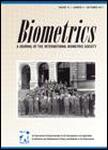版权所有:内蒙古大学图书馆 技术提供:维普资讯• 智图
内蒙古自治区呼和浩特市赛罕区大学西街235号 邮编: 010021

作者机构:Harvard Univ Sch Publ Hlth Dept Biostat Boston MA 02115 USA
出 版 物:《BIOMETRICS》 (Biometrics)
年 卷 期:1997年第53卷第4期
页 面:1384-1398页
核心收录:
学科分类:0710[理学-生物学] 07[理学] 09[农学] 0714[理学-统计学(可授理学、经济学学位)]
基 金:NIAID NIH HHS [AI24643] Funding Source: Medline
主 题:cross-sectional data differential selection EM algorithm generalized additive models incidence and prevalence penalized likelihood
摘 要:This paper considers nonparametric estimation of age-and time-specific trends in disease incidence using serial prevalence data collected from multiple cross-sectional samples of a population over time. The methodology accounts for differential selection of diseased and undiseased individuals resulting, for example, from differences in mortality. It is shown that when a log-linear incidence odds model is adopted, an Ehl algorithm provides a convenient method for carrying out maximum likelihood estimation, primarily using existing generalized linear models software. The procedure is quite general, allowing a range of age-time incidence models to be fitted under the same framework. Furthermore, by making use of existing software for fitting generalized additive models, the procedure can be generalized with virtually no extra complexity to allow maximization of a penalized likelihood for smooth nonparametric estimation. Automatic choice of smoothing level for the penalized likelihood estimates is discussed, using generalized cross-validation, The method is applied to a data set on serial toxoplasmosis prevalence, which has previously been analyzed under the assumption of nondifferential selection. A variety of age-time incidence models are fitted, and the sensitivity to plausible differential selection patterns is considered. It is found that nonmultiplicative models are unnecessary and that qualitative incidence trends are fairly robust to differential selection.